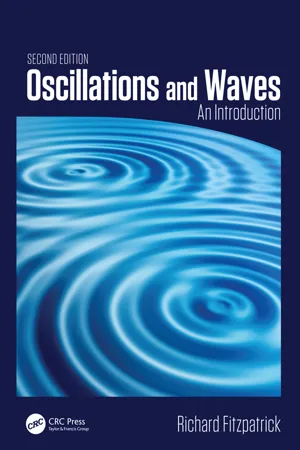
- 299 pages
- English
- ePUB (mobile friendly)
- Available on iOS & Android
About this book
Emphasizing physics over mathematics, this popular, classroom-tested text helps advanced undergraduates acquire a sound physical understanding of wave phenomena. This second edition of Oscillations and Waves: An Introduction contains new widgets, animations in Python, and exercises, as well as updated chapter content throughout; continuing to ease the difficult transition for students between lower-division courses that mostly encompass algebraic equations and upper-division courses that rely on differential equations.
Assuming familiarity with the laws of physics and college-level mathematics, the author covers aspects of optics that crucially depend on the wave-like nature of light, such as wave optics. Examples explore discrete mechanical, optical, and quantum mechanical systems; continuous gases, fluids, and elastic solids; electronic circuits; and electromagnetic waves. The text also introduces the conventional complex representation of oscillations and waves during the discussion of quantum mechanical waves.
Features:
- Fully updated throughout and featuring new widgets, animations, and end of chapter exercises to enhance understanding
- Offers complete coverage of advanced topics in waves, such as electromagnetic wave propagation through the ionosphere
- Includes examples from mechanical systems, elastic solids, electronic circuits, optical systems, and other areas
Frequently asked questions
- Essential is ideal for learners and professionals who enjoy exploring a wide range of subjects. Access the Essential Library with 800,000+ trusted titles and best-sellers across business, personal growth, and the humanities. Includes unlimited reading time and Standard Read Aloud voice.
- Complete: Perfect for advanced learners and researchers needing full, unrestricted access. Unlock 1.4M+ books across hundreds of subjects, including academic and specialized titles. The Complete Plan also includes advanced features like Premium Read Aloud and Research Assistant.
Please note we cannot support devices running on iOS 13 and Android 7 or earlier. Learn more about using the app.
Information
CHAPTER 1
Simple Harmonic Oscillation
1.1 INTRODUCTION
1.2 MASS ON SPRING

Table of contents
- Cover
- Half Title
- Title Page
- Copyright Page
- Table of Contents
- Preface
- Chapter 1 Simple Harmonic Oscillation
- Chapter 2 Damped and Driven Harmonic Oscillation
- Chapter 3 Coupled Oscillations
- Chapter 4 Transverse Standing Waves
- Chapter 5 Longitudinal Standing Waves
- Chapter 6 Traveling Waves
- Chapter 7 Multi-Dimensional Waves
- Chapter 8 Wave Pulses
- Chapter 9 Dispersive Waves
- Chapter 10 Wave Optics
- Chapter 11 Wave Mechanics
- Bibliography
- Index